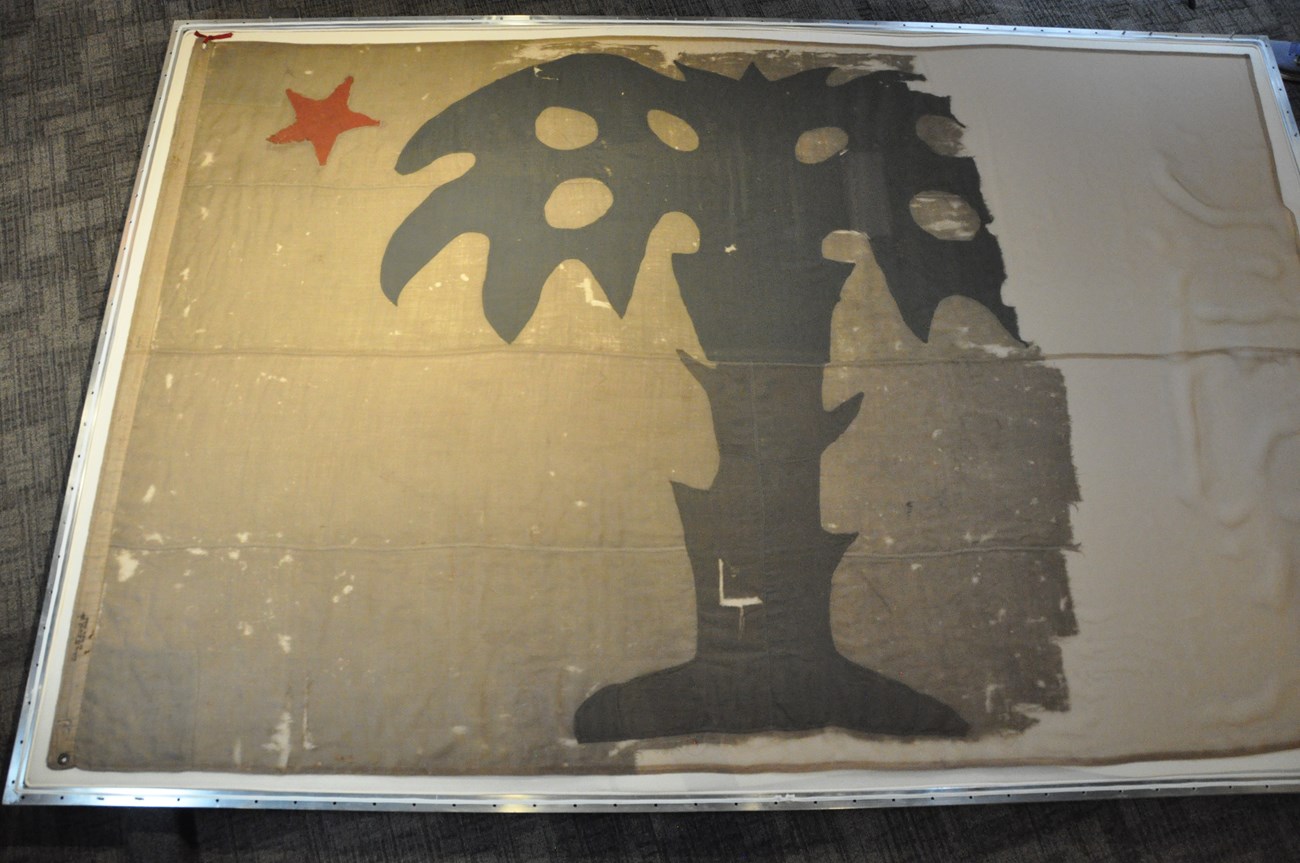Last updated: April 1, 2025
Article
The Palmetto Guard Flag

NPS/M. Buchanan
A Revolutionary Symbol
The primary symbol on the Palmetto Guard flag was not new at the time of the Civil War. Instead, it springs from South Carolina’s fight for independence against the British during the American Revolution.
In 1776, Patriots under Colonel William Moultrie successfully defended a fort on Sullivan’s Island, at the mouth of Charleston Harbor. The fort, later renamed Fort Moultrie, was made of palmetto tree logs – a building material found in large quantities on the South Carolina coastline. During the battle, British cannon fire failed to do significant damage to the fort, in part because the logs were flexible and resilient against incoming fire. [1]
The Patriot victory made the palmetto tree an enduring symbol of South Carolina’s resilience against the British. It became associated with a state holiday known today as “Carolina Day”, numerous civic organizations, and a militia unit – the Palmetto Guard. [2]
Flags and Militiamen
The Palmetto Guard was one of many militia units in pre-Civil War Charleston, appearing in local newspaper advertisements as early as 1851. [3] When South Carolina announced its secession from the United States on December 20, 1860, the militia units would be the state’s first organized military.
Throughout the secession crisis, the Palmetto tree took on a new meaning. South Carolina politicians looked back to the Revolutionary symbol and linked it with their current attempt at “independence”. In January 1861, South Carolina’s legislature adopted a new official state flag, bearing a white palmetto tree in the center, a crescent in the upper left corner, and a dark blue field behind it. With a few small modifications, this remains the state flag today. [4]
The Palmetto Guard flag was slightly different. The flag consisted of a white field, a dark brown and green palmetto tree in the center, and a red star in the upper left corner. The “single star” stood for “state sovereignty” or independence. [5]
First Shots, First Flag
Throughout the secession crisis, South Carolina militia units like the Palmetto Guard were engaged in a tense standoff with the US garrison at Fort Sumter, a centrally placed harbor fort. By early April 1861, the Palmetto Guard was stationed on Morris Island, within firing range of Fort Sumter and the US soldiers.
On the early morning of April 12, the Confederate positions around the harbor began shelling Fort Sumter with artillery fire. Captain G.B. Cuthbert of the Palmetto Guard described his regiment’s activity:
“At the dawn of day the Iron Battery commenced its work of demolition. The first shell from columbiad No. 1, fired by the venerable Edmund Ruffin, of Virginia, burst directly upon the parapet of the Southwest angle of the fort…” [7]
After about 34 hours of bombardment, the US forces at Fort Sumter agreed to evacuate the fort, and the fort was physically taken by the Confederates on April 14th. Ruffin carried the flag into the fort, and another Confederate soldier raised it over Fort Sumter. The fort was in Confederate hands – as it would be until February 1865. [8]
The Flag’s Legacy
The Palmetto Guard soon became part of the 2nd South Carolina Infantry Regiment and fought in many of the major campaigns of the war, mostly with the Army of Northern Virginia.
The South Carolina state flag still bears the palmetto tree symbol. However, the tree is still mostly remembered for its successful Revolutionary War defense of Charleston Harbor. Due to the Confederacy’s defeat, the flag’s association with the secession movement has become less well known.
The flag was eventually kept in the possession of John Styles Bird, Jr., a veteran of the Palmetto Guard who was present during the attack on Fort Sumter. A descendant of Pvt. Bird gave the flag to Fort Sumter and Fort Moultrie National Historical Park in 1979. [9] Its colors are now faded, with the formerly white background now bearing a beige appearance. The fragile flag was kept on display from 1985 until 2023. It is now in the park’s museum resting the artifact from light exposure.
Citations:
[1]: “Sullivan’s Island”. American Battlefield Trust. Accessed via battlefields.org: https://www.battlefields.org/learn/revolutionary-war/battles/sullivans-island-south-carolina
[2]: Butler, Nic. “The Story of Carolina Day”. Charleston County Public Library, 2018 June 22. Accessed via ccpl.org: https://www.ccpl.org/charleston-time-machine/story-carolina-day
[3]: “Palmetto Guard.” The Charleston Daily Courier, 1851 July 19. Accessed via newspapers.com: https://www.newspapers.com/image/604528878/
[4]: “The Flag of South Carolina”. The Charleston Mercury, 1861 Feb. 2. Accessed via newspapers.com: https://www.newspapers.com/image/605450849/
[5]: “What Shall Be the Flag?” The Charleston Mercury, 1860 Nov. 20. Accessed via newspapers.com: https://www.newspapers.com/image/605447985/
[6]: “The Palmetto Guard”. Richmond Dispatch, 1861 May 13. Accessed via newspapers.com: https://www.newspapers.com/image/80617469/
[7]: The War of the Rebellion: A Compilation of the Official Records of the Union and Confederate Armies. Series I – Volume I. P. 54.
[8]: Ringold, May Spencer, and W.G. Young. “William Gourdin Young and the Wigfall Mission – Fort Sumter, April 13, 1861”. The South Carolina Historical Magazine, Jan. 1972, pp. 27-36. Accessed via jstor.org: https://www.jstor.org/stable/27567098?seq=1
[9]: Burton, Beatrice, et al. Fort Sumter and Fort Moultrie National Historical Park Administrative History. Nov. 2020, p. 127. Accessed via npshistory.com: https://npshistory.com/publications/fosu/adhi.pdf
